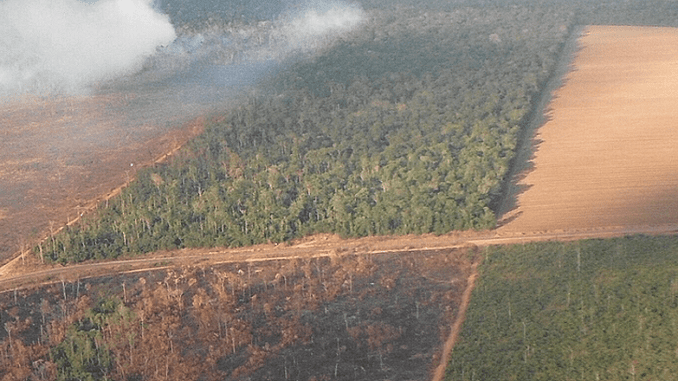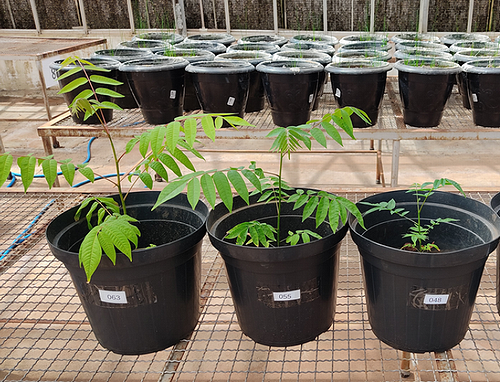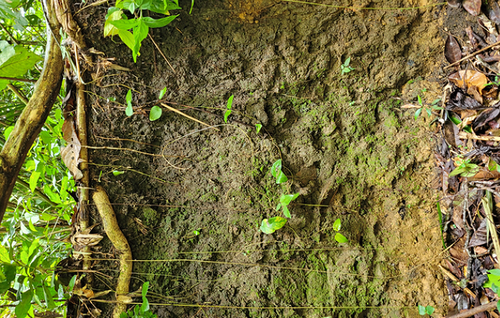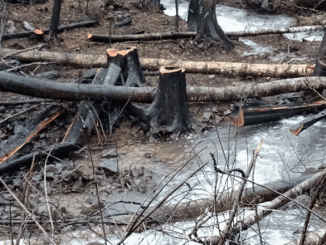
SAO PAULO, Brazil, May 7, 2023 (ENS) – Millions of Amerindian people living centuries ago in today’s Amazonia transformed the originally poor soil. The result is Amazonian dark earth, ADE, or terra preta, fertile and rich in nutrients and stable organic matter derived from charcoal, which imparts its black color.
Over many human generations between 450 BCE and 950 CE, soils were enriched with charcoal from low-intensity fires for cooking and burning refuse, animal bones, broken pottery, compost, and manure.
Now, scientists from Brazil show that ADE could boost reforestation, not only in the Amazon, where 18 percent or 780,000 km2 of forest has been lost since the 1970s, but around the world. The results are published in the journal “Frontiers in Soil Science,” under the title, “Amazonian dark earths enhance the establishment of tree species in forest ecological restoration.”
“Here we show that the use of ADEs can enhance the growth of pasture and trees due to their high levels of nutrients, as well as to the presence of beneficial bacteria and archaea in the soil microbial community,” said joint lead author Luís Felipe Zagatto, a graduate student at the Center for Nuclear Energy in Agriculture of São Paulo University, Brazil.
“This means that knowledge of the ingredients that make ADEs so very fertile could be applied to help speed up ecological restoration projects,” Zagatto said.
Mimicking Reforestation in Miniature
The researchers conducted controlled experiments to mimic the ecological succession and changes to the soil that happen when pasture in deforested areas is actively restored to forest.
Their aim was to study how ADEs, or soils of which the microbiome was artificially composed to imitate them, can boost this process.
Zagatto and colleagues sampled ADE from the Caldeirão Experimental Research Station in the Brazilian state of Amazonas, and as a control, agricultural soil from the Luiz de Queiróz Superior School of Agriculture in the state of São Paulo.
They filled each of 36 four-liter pots with 3kg soil, inside a greenhouse with a mean temperature of 34 degrees Celsius to anticipate global warming beyond current temperatures in Amazonia between 22 and 28 degrees Celsius.

One-third of the pots received only control soil, another third a 4:1 mixture of control soil and ADE, and another third 100 percent ADE.
To imitate pasture, they planted seeds of palisade grass (Urochloa brizantha), common forage for livestock in Brazil, in each pot and allowed its seedlings to grow for 60 days. They then cut the grass and let only its roots remain in the soil – virgin territory for reforestation in miniature.
The researchers then planted each of the three soils with tree seeds: either with the colonizing species Ambay pumpwood (Cecropia pachystachya), with Peltophorum dubium typical of secondary forests, or with cedro blanco (Cedrela fissilis), typical of climax forest.
The seeds were allowed to germinate, and the seedlings to grow for 90 days, after which the height, dry mass, and extension of the roots were measured. The scientists quantified changes in the soil’s pH, texture, and concentration of organic matter, potassium, calcium, magnesium, aluminium, sulfur, boron, copper, iron, and zinc over the course of the experiment.
With molecular methods, they also measured changes in microbial diversity in the soil.
Rich in Nutrients
At the start, ADEs showed greater amounts of nutrients than control soil. For example, there was 30 times more phosphorus and three to five times more of each of the other measured nutrients, except manganese.

ADE also had a higher pH and contained more sand and silt, but less clay than control soils.
After the experiment, soils contained less nutrients than at the start, reflecting take-up by the plants, but 100 percent ADE soils remained richer in these than control soils, while nutrient levels were intermediate in 20 percent ADE soils.
Throughout the experiment, 20 percent or 100 percent ADE soils supported a greater biodiversity of bacteria and archae micro-organisms than control soils.
“Microbes transform chemical soil particles into nutrients that can be taken up by plants. Our data showed that ADE contains microorganisms that are better at this transformation of soils, thus providing more resources for plant development,” said joint lead author Anderson Santos de Freitas.
ADE Found to Boost Growth
The results also showed that adding ADE to soil improved the growth and development of plants. The dry mass of palisade grass, for example, was increased 3.4 times in 20 percent ADE, and 8.1 times in 100 percent ADE, compared to in control soil.
Addition of ADE also boosted the growth of the three tree species: seedlings of cedro blanco and P. dubium were 2.1 and 5.2 times taller in 20 percent ADE, and 3.2 and 6.3 times taller in 100 percent ADE, compared to in control soils.
Ambay pumpwood didn’t even grow in control soils or 20 percent ADE, but thrived in 100 percent ADE.
The researchers concluded that ADE can boost plant growth. “Our data point to a mixture of soil nutrients and adapted microorganisms [in ADE] to improve the establishment of plant trees in restoration,” they wrote.
Senior author Dr. Siu Mui Tsai, a professor at the Cell and Molecular Biology Lab, Center for Nuclear Energy in Agriculture, University of São Paulo, cautioned, “ADE has taken thousands of years to accumulate and would take an equal time to regenerate in nature if used. Our recommendations aren’t to utilize ADE itself, but rather to copy its characteristics, particularly its microorganisms, for use in future ecological restoration projects.”
Featured image: A burned and fragmented forest in the Brazilian Amazon. A collaboration led by an Oregon State University College of Forestry researcher used very-high-resolution satellite imagery to record this snapshot. September 1, 2015 (Photo by Oregon State University)



